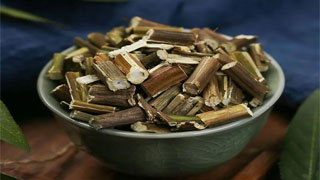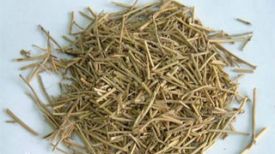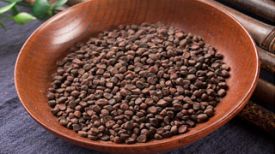
1. Aliases
Perilla stem, Perilla stem, Perilla stem, Perilla grass, Perilla branch stem.
2. Plant morphology
Annual herbaceous plant. Height: 0.3-1.5 meters. The stem is upright, green or purple, densely covered with long soft hairs. Single leaf opposite; Leaves ovate to broadly ovate; The petiole is 3-7 centimeters long. Umbrella inflorescence, with 2 flowers, arranged in a lateral raceme, densely covered with villous hairs; Bracts broadly ovate or nearly circular, covered with reddish brown glandular dots on the outside; Calyx bell shaped, approximately 3 millimeters long, growing to 12 millimeters when fruiting, with 5 sepal teeth, 3 teeth on the upper lip, and 2 teeth on the lower lip; The corolla is white to purplish red in color, with a slanted bell shaped throat and a two lipped brim. The upper lip tip is slightly concave, and the lower lip is 3-lobed; 4 stamens, 2-strong, with 2 anthers and flattened filaments; The ovary is fully 4-lobed, the style base is attached, the apex is 2-lobed, and the front of the disk is enlarged in a finger like shape. The small nut is nearly spherical, with a diameter of 1.5-2 millimeters, and a grayish brown surface with slightly raised dark brown mesh patterns. The flowering period is from June to August, and the fruiting period is from August to October.
3. Origin distribution
Perilla is a cultivated variety widely cultivated in China.
4. Harvesting and processing
After the autumn fruits mature, harvest and remove impurities, sun dry them, or slice them fresh and sun dry them.
5. Characteristics of medicinal herbs
Square columnar, with four blunt edges and varying lengths, with a diameter of 0.5-1.5 centimeters. The surface is purple brown or dark purple, with longitudinal grooves and fine longitudinal lines on all sides, slightly swollen nodes, and opposite branch and leaf marks. Lightweight, hard in texture, with a cracked cross-section. Slices are 2-5 millimeters thick, often in an oblique rectangular shape. The xylem is yellow white, with dense rays and a radial shape. The pulp is white, loose or detached. The air is slightly fragrant and the taste is light.
6. Nature, taste, and meridian tropism
Warm in nature and spicy in taste. Return to the lung meridian and spleen meridian.
7. Effect and function
Regulating Qi, relieving pain, and ensuring safe pregnancy. It belongs to the category of regulating qi medicine.
8. Clinical applications
Dosage 5-9 grams, decoct soup and take orally. Used to treat chest and diaphragm tightness, epigastric pain, heating and vomiting, and fetal restlessness.
9. Pharmacological research
Pharmacological experiments have shown that it has a progesterone like effect and, like progesterone, can promote the growth of endometrial glands.
10. Chemical composition
Containing volatile oil, the oil mainly contains perilla aldehyde, 1-limonene, α - pinene, β - pinene, β - syringene, α - limonene, and linalool. It also contains perilla ketone, isoproterenone, perilla ketone, perilla ketone, arginine, oxalic acid, perilla glycoside, and linolenic acid.
11. Taboos for use
Not yet clear, use medication with caution.
12. Compatibility prescription
① After treating typhoid and febrile diseases, waking up early and having a heavy diet can lead to fatigue and recovery: one or two stems and leaves of perilla (filed), half a liang of ginger (cut), and one or two blends of black beans. Add three flavors, use two and a half cups of water, fry until a large one, and remove any residue. Warm before meals, take twice a day. (Pu Ji Fang Zi Su Yin)
② Treating cough caused by excessive qi: Two liters of perilla stems and leaves, one liter of soybeans. Boil soybeans in 4 liters of water for the first two flavors, then add perilla and take 1 liter of quinone. It is divided into three uniforms, with two days and one night. (Outer Platform)
③ Treatment for fetal gas imbalance, chest tightness and nausea in pregnant women: 9g each of Su Gan and Pinellia ternata, 3 slices of ginger, and 5g of tangerine peel. Boiled in water. [Traditional Chinese Medicine and Clinical Research 1986, (3): 47]
④ To treat athlete's foot and prevent excessive qi: the stems and leaves of perilla are divided into three parts (two parts), the white front is one or two parts, and the mulberry roots and white are two or two parts (filing). Take the medicine and grind it into powder. Take four coins per serving, one medium cup of water, half a portion of ginger, fry until six cents, remove impurities, regardless of time, and warm up. (Shenghui Fang)
⑤ To treat vomiting and bleeding: three coins for white thatch and two coins for perilla stems and leaves. Up scattering. Take a new bowl of water and fry it for seven minutes. Heat it up and stir fry to make two coins of cattail yellow. Take it and spin it off. Still simmer two garlic seeds until cooked, flatten them, apply them to the soles of both feet, lean slightly, and feel the presence of garlic in the chest, causing the blood to stop. If there is bleeding from the lower part, you can simmer garlic and apply it to the palms of two palms. ("Zhi Zhi Fang" Mao Su Tang)
The content of the article is for clinical reference only. Non professionals in traditional Chinese medicine are not allowed to try medication.


